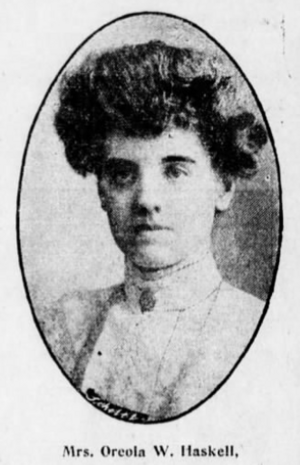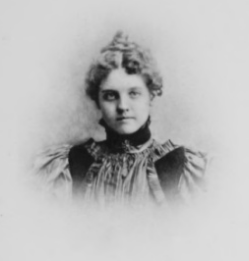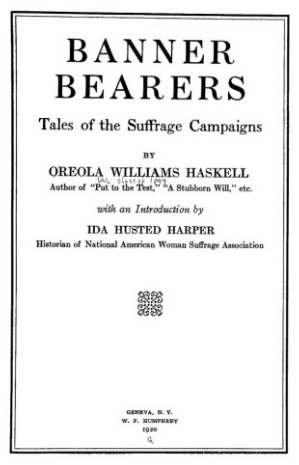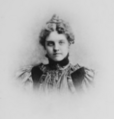Oreola Williams Haskell facts for kids
Oreola Williams Haskell (1875–1953) was an American activist, author, and poet in the early 1900s. She was a strong supporter of suffrage, which means the right to vote, especially for women.
Contents
Early Life and Family
Oreola Williams Haskell was born on April 14, 1875, in Poultney, Vermont. When she was about five years old, her family moved to Brooklyn, New York. She passed away in Brooklyn on September 6, 1953.
Her Influential Mother
Oreola's mother, Martha J. Williams (1854-1939), was a very important leader in the women's suffrage movement. She was involved in many groups that worked to get women the right to vote in New York City.
Martha was:
- A founding member of the Interurban Woman Suffrage Council.
- President of the Harlem Woman Suffrage League.
- President of the Kings County Political Equality League.
- A leader for press relations for suffrage clubs.
It's clear that Martha's work greatly influenced Oreola. They even worked together on some projects, like a press release for Susan B. Anthony's birthday party in Brooklyn. Oreola handled youth outreach, while Martha managed the press. This experience likely helped Oreola follow in her mother's footsteps.
Her Father and Husband
Oreola's father, Theodore Williams, was a journalist, editor, and poet. He wrote poetry under the name Tudor Williams. He worked for important news organizations like the Associated Press and Leslie's Weekly. It's possible his connections helped Oreola get her own writings published.
Oreola met her husband, Robert Hutchins Haskell (1874–1965), while they were both working on a student newspaper at Cornell University. Robert later became a lawyer and was a leader in the Farmer-Labor Party of Brooklyn. They got married in 1901 and had a daughter named Grace Vivian Haskell.
Her Daughter, Grace
Grace Vivian Haskell (1907–1999) was born in New York. She helped her mother with some charity work, like the Brooklyn Sittig Christmas Tree Society. However, it's not known if she was involved in the suffrage movement like her mother and grandmother.
Education and Early Career
Oreola graduated from Girl's High School in Brooklyn, where she was named the Class Poet. At just 17, she started her own group called the Oreola Progressive Society.
She then went on to Cornell, where she earned a degree in Philosophy. At Cornell, she was part of the editorial teams for two student newspapers, the Era and the Magazine. She was also named Class Poet by her fellow students.
After college and before she got married, Oreola worked as a public school teacher in Brooklyn.
Career and Activism
Oreola Williams Haskell was a very busy woman. She was a dedicated author and a passionate activist for women's right to vote.
She wrote her own novel, Banner Bearers, and contributed regularly to magazines like Judge. She worked closely with famous suffragists such as Carrie Chapman Catt and Mary Garrett Hay.
Ida Husted Harper, who wrote the introduction to Haskell's book, praised her for being humble and not seeking fame. This fit with Oreola's belief that suffragists should be selfless and work hard behind the scenes. People noted her quiet, efficient, and hardworking attitude. She was seen as a great example of the many diligent suffragists who worked tirelessly without always being in the spotlight.
Besides her suffrage work, she was also involved in high society and charity. She was an auditor and recording secretary for the New York Federation for Women's Clubs. In 1914, she was a patroness of the Brooklyn Sittig Christmas Tree Society. Although her contributions to the suffrage movement in New York are not widely known today, newspaper articles from the Brooklyn Daily Eagle show she was a well-known and respected figure in her time.
Oreola was a Unitarian, and she enjoyed theater, outdoor sports, and walking.
Works
Oreola Williams Haskell was a talented writer, creating both fiction and non-fiction works.
Her Book: Banner Bearers
Her novel, Banner Bearers: tales of the Suffrage Campaigns, was published in 1920. It was a fictional story that showed what the suffrage movement was like. It might have been the first novel about suffrage written in an "epistolary style," meaning it was told through letters or different voices.
The book was inspired by the suffrage campaigns in New York between 1915 and 1917. Many suffragists believed it helped influence the passing of the Nineteenth Amendment, which gave women the right to vote. The novel featured 22 different characters, showing a wide range of suffragist experiences.
Haskell based many of her characters on real suffragists. The Daily Brooklyn Eagle newspaper even revealed some of the real people behind the characters, suggesting it was a fun "inside joke" for people at the time. For example:
- "Sizing Up a Boss" was about Mary Garrett Hay.
- "The Heart of a Chief" was about Carrie Chapman Catt.
Her Plays
Oreola Haskell also wrote plays that supported the suffrage cause. These plays became popular during a time when pro-suffrage plays and pageants were gaining attention.
- "Put to the Test" (1906)
- This play made fun of arguments against women's voting rights. It showed that women's "indirect influence" (like guiding their families) wasn't enough; they needed the vote.
- It was a comedy and was very successful both financially and with critics.
- Local suffragists acted in the play, which was produced by the Stanton League. It was so popular that Haskell couldn't keep up with requests for scripts, so it was published in the Woman's Journal newspaper.
- "A Stubborn Will" (1909)
- This play was performed many times, though it wasn't as successful as "Put to the Test."
It's believed that Haskell wrote three suffrage plays in total. One of her plays was even translated into Norwegian and performed in Norway!
Non-Fiction Writings
Haskell also wrote many non-fiction articles for various publications, often focusing on women's issues and the suffrage movement. Some of her articles include:
- "To Enrolment Chairmen," Woman's Journal (1908)
- "Canvassing for the Cause," Woman's Journal (1912)
- "The New Wife," Woman Voter (1912)
- "Carrie Chapman Catt," Today's Housewife (1923)
She also contributed to the "New York City Campaigns" section in the six-volume History of Woman Suffrage, a very important historical record of the movement. From 1922 to 1923, she regularly wrote for International Women's News about topics important to women.
Activism and Leadership
Oreola Williams Haskell was a dedicated leader in the suffrage movement.
Leadership Roles
She held many important positions in various suffrage organizations:
- Elizabeth Cady Stanton Political Equality League
- She was President from 1901 to 1903.
- Interurban Woman Suffrage Council
- She might have been a co-leader with Mary Garrett Hay.
- People's Political Equality League
- She was President in 1914.
- Kings County Political Equality League
- She became President in 1907.
- She also held various chairmanships in State National Suffrage organizations, including being Chairman of the City Woman Suffrage Party.
Membership
She was also a member of other important groups, such as:
- Flatbush Political Equal Suffrage League
- Kings County Political Equality League
Images for kids









